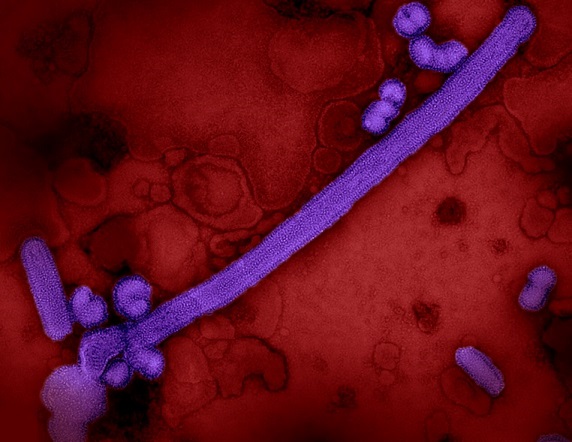U.S. NIH Study Finds That Influenza A Virus Adapts Its Shape to Survive and Spread
Nikhil Prasad Fact checked by:Thailand Medical News Team Feb 11, 2025 2 months, 2 days, 4 hours, 25 minutes ago
Medical News: A Virus That Changes Its Form to Survive
Scientists from the National Institute of Allergy and Infectious Diseases (NIAID), part of the U.S. National Institutes of Health (NIH), have made a remarkable discovery about the influenza A virus (IAV). They found that this virus can change its shape in response to different environmental conditions, switching between spherical and filamentous forms. This
Medical News report explores how this unique ability may help the virus persist in human populations, evade immune defenses, and adapt to new hosts.
 U.S. NIH Study Finds That Influenza A Virus Adapts Its Shape to Survive and Spread
U.S. NIH Study Finds That Influenza A Virus Adapts Its Shape to Survive and Spread
For a long time, researchers have observed that influenza A virus particles come in two distinct shapes - small spheres and longer filaments - but the reason behind this variation was unclear. Scientists previously believed that these shapes were predetermined by the virus's genetic makeup. However, this latest study demonstrates that the virus can dynamically alter its shape depending on external conditions. This discovery is crucial because it provides new insights into how influenza spreads and survives, especially in hostile environments.
The Study’s Key Findings
The research team designed experiments to track the structure of the influenza virus in real-time, allowing them to observe how it responds to different conditions. Their findings revealed several important aspects:
-When the virus encounters obstacles that reduce infection efficiency, such as antiviral antibodies or host incompatibility, it shifts towards producing more filamentous particles.
-Filamentous viruses are harder to neutralize by the immune system, making them more likely to survive and continue infecting cells.
-The shape of the virus is not strictly determined by its strain but is instead influenced by external factors, such as the type of host cell and the presence of antiviral agents.
The team tested 16 different virus-cell combinations and observed consistent trends: when the virus faced increased immune pressure or replication difficulties, it produced more filaments, which seem to offer an advantage in resisting immune attack.
Why Filamentous Viruses Are Harder to Stop
Influenza A’s ability to shift between shapes suggests an important survival strategy. Filamentous viruses are larger and more structurally complex than spherical ones, requiring more energy to form. However, their unique shape helps them resist immune system attacks, such as antibody neutralization. This means that even when the body produces antibodies to fight off the infection, filamentous viruses may still evade destruction and continue to spread.
The researchers believe that this ability to change shape may also play a role in how influenza adapts to new hosts and survives over time. Other viruses, such as measles, Ebola, Nipah, Hendra, and respiratory syncytial virus (RSV), also display similar mixed-shap
e strategies. This suggests that changing shape could be a common tactic among many viruses to enhance their survival and infection potential.
How the Study Was Conducted
To examine these shape changes, the researchers developed a flow virometry assay, a highly sensitive technique that allowed them to analyze virus particles in different environments. They looked at various factors influencing shape, including:
-Virus strain differences
-Host cell type variations
-The presence of antiviral antibodies
-Replication efficiency
They found that the virus adjusted its shape within minutes of encountering antibodies or entering a new host environment. This quick adaptation allows influenza to maintain its infectivity even in challenging conditions.
What This Means for Future Research
The findings of this study highlight an important but previously unrecognized feature of influenza A virus biology. If scientists can better understand how these shape changes influence infection efficiency, new antiviral treatments could be developed to target the virus more effectively. For example, drugs that prevent filament formation might help weaken the virus's ability to evade immune defenses.
Moreover, these findings may also help explain why some strains of influenza spread more easily or cause more severe infections than others. By studying how different viruses use shape adaptation, researchers may be able to predict which influenza strains pose the greatest risk for future pandemics.
Conclusion
The discovery that influenza A virus can dynamically adjust its shape in response to environmental pressures is a significant breakthrough in virology. This ability allows the virus to survive, evade immune responses, and potentially adapt to new hosts with greater efficiency. The study demonstrates that shape-shifting is a conserved feature among different strains of influenza A and is likely an evolutionary advantage that enhances the virus's ability to persist and spread.
Understanding this process may pave the way for more effective vaccines and antiviral treatments that specifically target shape-shifting mechanisms. Future research will focus on determining the exact molecular mechanisms that control these shape changes and how they can be disrupted to prevent influenza infections.
The study findings were published in the peer-reviewed journal: Nature Microbiology.
https://www.nature.com/articles/s41564-025-01925-9
For the latest research on the Influenzas A virus, keep on logging to Thailand
Medical News.
Read Also:
https://www.thailandmedical.news/news/new-insights-into-influenza-a-virus-receptors-and-potential-treatments
https://www.thailandmedical.news/news/new-approach-using-traditional-japanese-medicine-and-minocycline-for-influenza-treatment
https://www.thailandmedical.news/articles/influenza-or-flu
